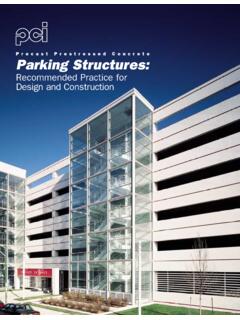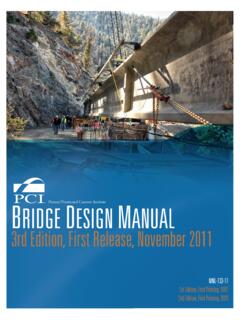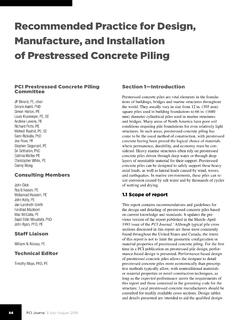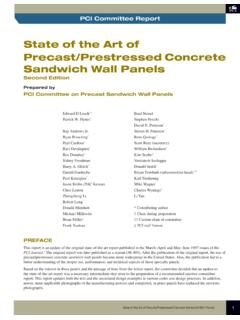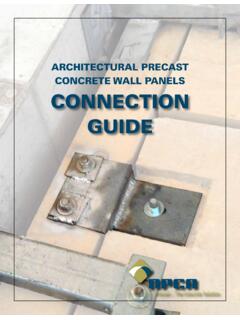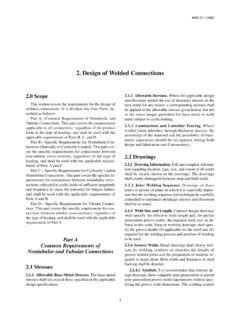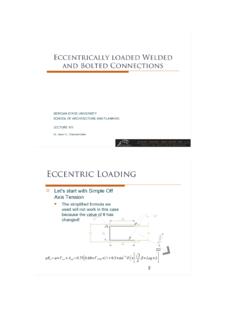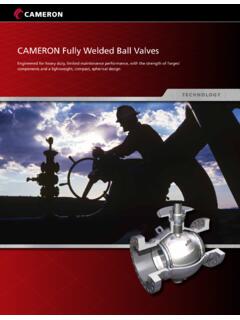Transcription of Precast concrete double-tee connections, part 1: Tension ...
1 Editor s quick pointsn This paper shows that flange connections in topped diaphragm systems provide a high initial tensile resistance but provide the same response as an untopped system once the topping reinforcement The strength of both chord and flange connections is over-predicted by PCI equations because of brittle modes of weld Simplified models were developed to more accurately estimate the deformation capacity and concrete double-tee connections, part 1: Tension behaviorClay Naito, Liling Cao, and Wesley PeterPrecast concrete double-tees are commonly used for long-span floor systems in buildings and parking structures throughout the United States.
2 Such systems are quick to erect, economical in cost, and help to resist lateral forces during seismic events. To provide integrity in the floor system, mechanical connectors are embedded in the double-tee flanges during manufacturing and are welded to adjacent double-tees during erection in the field. A Precast concrete double-tee is typically fabricated with a (50 mm) flange and topped in the field with cast-in-place concrete or fabricated with a (100 mm) pretopped flange (Fig. 1).For a regular floor diaphragm system spanning Precast concrete frames or shear walls, the seismic demands on the joint connections are based on a girder In this model, the diaphragm is assumed to act as a simple beam under a uniform load subjecting each joint to a combina-tion of moment and shear.
3 The connections at the bound-ary edges of the joint are designed to resist the Tension and compression forces generated from bending of the diaphragm, and intermediate connections are designed to resist the shear within the connections located at the boundary edges are referred to as chord connections, and the connections placed be-tween the chords are referred to as web connections. While the methodology provides a simple means for designing floor diaphragms, previous research has shown that con-ventional floor diaphragms are subjected to complex force and deformation demands under seismic events that are not effectively modeled by the girder , because the girder analogy is a force-based design method, it does not account for the deformation capacity of the connection .
4 In some cases, the web or chord connections may 49 PCI Journal | Winter 2009 Winter 2009 | PCI Journal50In high seismic zones, engineers have relied on category I connections, which consist of a (50 mm) rein-forced cast-in-place topping slab overlaying a Precast concrete double-tee to ensure structural integrity. For these systems, reinforcing bars are used to provide con-tinuity over the double-tees. As an alternative, systems con-sisting of a mechanical connection (category III) embedded in (100 mm) pretopped double-tee flanges are used.
5 These systems are referred to as dry systems because they do not require the use of a field-placed topping. The embedded connection is typically field welded to the adja-cent connection by a round or rectangular slug between the two exposed-steel-plate faces. Field erection requirements, such as leveling of the double-tees, often require the use of the welded mechanical connections even in low or moder-ate seismic regions. To provide a smooth and level floor surface, a combination of both a mechanical connection and cast-in-place topping (category II) is this paper, the embedded mechanical connections are classified in five subcategories based on their physical attributes (Table 1).
6 5 Types DT1 through DT4 represent connections that can be fabricated from the reinforcing bar, plate, and angles. Category DT5 represents various proprietary connections that have been developed for use in Precast concrete double-tees. Of the five connec-tion types, bent reinforcing-bar connections (DT1) and proprietary connections (DT5) are the most popular web connections used in the United States for new construc-tion. The pretopped or dry-chord connection consists of an embedded bar-to-plate connection (DT3). For topped conditions, continuous reinforcing bars are cast into the topping or into an elevated pour strip to provide the chord strength (Fig.)
7 1).have limited deformability and result in premature failure of a floor diaphragm joint. To address these concerns, a collabora-tive research program has been conducted to develop a seismic design methodology for Precast concrete ,4A key goal of the research is to characterize diaphragm connec-tions from both a force- and displacement-capacity perspective. This allows for selective design of diaphragms by targeting a high deformation capacity while providing a combined shear and Tension force resistance of both the web and chord connec-tions in seismic regions where they are needed.
8 This research program targets diaphragm connections commonly used by Precast concrete producers. This paper presents the in-plane Tension performance of pretopped and field-topped con-nection systems used in the Precast concrete survey of connection detailsA wide variety of double-tee connections are in use by the Precast concrete industry. To categorize common connec-tions used in the United States, a survey of Precast concrete producers and designers was conducted and the results are detailed in Table double-tee connection types are classified into three major categories:Category I: cast-in-place topping without an embed- ded connectionCategory II: cast-in-place topping with an embedded mechanical connectionCategory III: pretopped Precast concrete double-tee with an embedded mechanical connectionFigure 1.
9 Precast concrete double-tees are typically fabricated with a (50 mm) flange and topped in the field with cast-in-place concrete or fabricated with a (100 mm) pretopped flange. Also shown are typical Precast concrete double-tee diaphragm diaphragm supportDiaphragm wall 1 Diaphragm (panel-to-panel interaction)Diaphragm wall 2 Field toppedPretoppedChord reinforcementin end pour stripFlange-to-flangewebreinforcementCho rd reinforcementin intermediatepour stripChordChordWebFloor Plan51 PCI Journal | Winter 2009 Table 1.
10 double-tee connection detailsEmbedded mechanical connectorsDT1 embedded bent bar only DT2 continuous barDT3 embedded bar end welded to steel plateDT4 cover plateDT5 proprietary connectorsNote: 1 in. = 2009 | PCI Journal52and 15 As an initial step of the project, these past studies were quantified in a database of response Examination of the existing data revealed that while the past research has been extensive, shortcomings remain with regard to the range of connections examined and the method of evaluation majority of research focused on the performance of web connections.
